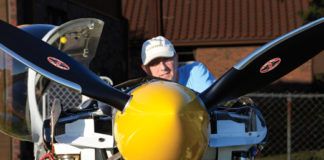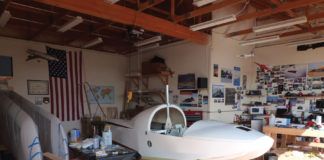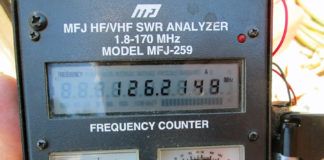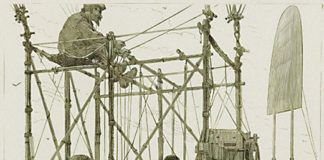You’ve spent thousands of hours meticulously working on your homebuilt. Perhaps sanding your composite aircraft has lasted hundreds of hours just to get it ready for that perfect finish. Or maybe your aluminum airplane is now ready for its new coat of paint. Throughout the build process, you have likely tossed around different design ideas and undoubtedly admired myriad aircraft. Now its crunch time: What will your paint scheme be?
When you think of it, the design that you choose for your airplane reflects many things-your personality, style and creativity, to name a few. And no matter how many hours you have spent working on your project, the first thing people will comment on is how the plane looks, its aesthetics. Where do you go to find just the right design for your plane, and how do you get the design from your brain to your plane?
Pete Johnson (above), a Kitfox owner, said that when he was ready for his paint job, he logged onto the Kitfox web site and scanned the photos in its gallery in search of a design. He eventually settled for the classic yellow and blue of the original Kitfox. The majority of builders who were asked stated that their aircraft manufacturers web site was the first stop when shopping for artwork. Others began by tearing pages out of magazines or heading out to take pictures of aircraft at airshows.
Gale Grant, a Cherokee driver at Corona Airport (AJO), in California, says that hes not one to surf the web, so he headed to his airport and enjoyed a cup of coffee on “The Bench” to watch the planes. With aircraft landing all day for fuel, he saw enough variety to obtain a design idea to take to his painter. However, quite a few builders felt that a pilgrimage to Oshkosh was necessary to find that perfect design.
Personality Test
No matter how you approach the design acquisition process, you will begin to see a similarity between your personality and your style as the photos are gathered. Take the photos you’ve accumulated and start whittling down what you have saved to a workable handful. This step will give you a real feel for your personal style. Do you prefer sleek lines and symmetrical stripes? Pilots we spoke to have been fairly consistent in their responses, indicating that men tend to lean towards linear artwork, while women tend to prefer a bit more curve.
Grant proffers that men like straight lines because they are easier to design and are more budget effective than the time-consuming setup required by the painter for either curves or airbrushed artwork. But Kent Pielemeier of Century Aircraft Painting in Chino, California, disagrees with that logic. He began his apprenticeship at the age of 13 by watching custom painters work on cars and boats, and he says that designs are not a big deal. Understanding the painting process makes it clear that its just as reasonable to paint stripes or curves, so don’t let someone tell you otherwise, he says.
If you are having difficulty getting your vision on paper, you might try Scheme Designers. Craig Barnett works with clients by listening to their ideas, looking at the designs they have accumulated, and having them check his and other aviation web sites for ideas. He will work with clients until the design is exactly what they want, no matter how many re-designs it takes to satisfy them. The design and schematics can then be taken to a painter, or builders can use them to do the job themselves (see sidebar for Barnetts tips).
Just Picture ItPielemeier says that most pilots know exactly what they want when they walk through the door of his paint shop. The hardest part of the process, if they do not bring pictures, is getting the design from their head to his and then onto paper. Pilots have often already decided what colors they want, and if he feels that the design will be lackluster based on their choices, he tells them so.
If the aircraft is to be tied down outside, rather than hangared, you might want to shy away from reds and yellows, as they have more pigment and will fade more rapidly than other colors. Clear-coating the plane (he uses three coats) provides UV protection. Pielemeier also discusses visibility issues with clients. A plane with certain colors on it will show up in the sky much better than an all white or all blue aircraft. In terms of safety, visibility is a key aspect to consider when deciding on paint colors.
If you want to add decals to your plane, you can send a photo to a shop and have decals made in the design and colors of your choice. Moody Aero-Graphics, Inc., of Belleview, Florida, has a catalog of decals for aircraft, including vintage planes, as does the similarly named AeroGraphics of Loveland, Colorado. These can be applied simply by wetting them in a soapy water mixture, setting them in place and then using a squeegee to remove the air bubbles. The decals have a pressure-sensitive adhesive that will hold them in place. According to the company, the decals will weather well for two to seven years if the plane is outside, or twice as long if it is hangared, depending on the colors. When placing the decals, pay close attention to curved surfaces, as they can be tricky. No need to clear-coat over decals. One caution, however, is that decals do not adhere well to rivets, so you might want to avoid decal application in those areas.
A Sound Investment
With plansbuilt and kit projects, so much work has been invested in the aircraft that most builders want a unique paint design. But what happens when you have to sell the plane? Mike and Tammy Salzman are sure they will never sell their Lancair ES, so Tammy created much of the artwork herself. Mike loves watching girls in pink bikinis, so there’s a hot pink bikini top on both sides of the forward fuselage. Tammy designs quilt patterns and hand-dyes fabrics for quilters, so the rudder displays her first published quilt design.
The couple provided full-scale line drawings to an airbrush artist, and he had a sign shop cut the shapes onto masking material that allowed for intricate design work at a reasonable cost. Although the airbrush artist (whose expertise was in painting motorcycle fuel tanks) had never painted an aircraft, he helped create a memorable design that will never be duplicated. Will another pilot appreciate the design work? Perhaps not, because it is so specific to the Salzmans, and this may cut into the marketability and/or resale value of the airplane. But they’re happy with it.
Identity Theft
One thread that needs to be mentioned, and its one that was expressed consistently by the pilots we spoke with, is that they do not want another pilot to “steal” their paint design. Unfortunately, that may not be preventable. While some builders may have invested a chunk of change to get a personalized design for their airplane, others may come along and snap a photo of it for their own use. (Remember those folks who visit airshows for ideas?)
Skip Slater, a Scheme Designers client, recently hosted a fly-in at French Valley Airport (F70), in California, and noticed two aircraft with identical paint designs and colors. He was told that one pilot had seen the paint design of the other airplane the year before at a fly-in and copied it for his own completed project. Some would argue that imitation is the greatest form of flattery, but it may not seem that way to the pilot whos paid for that one-of-a-kind design.




